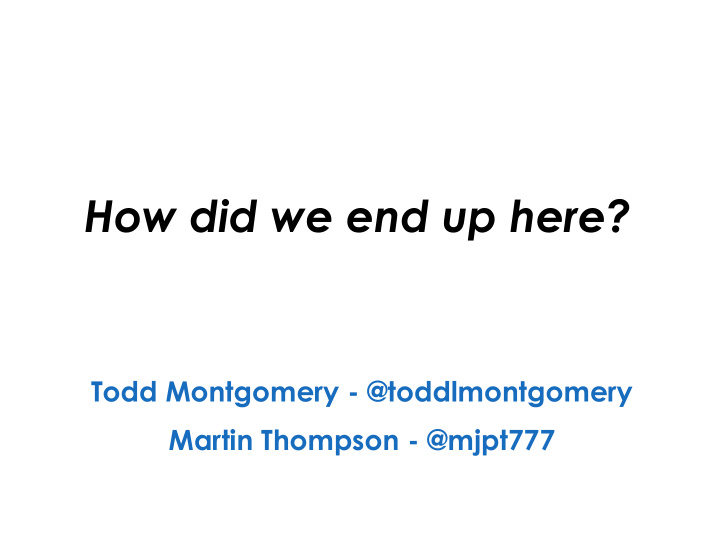



How did we end up here? Todd Montgomery - @toddlmontgomery Martin Thompson - @mjpt777
How bad can things really be?
Software Project Success Rates Successful Challenged Failure Ad-hoc 49% 37% 14% Iterative 61% 28% 11% Agile 60% 28% 12% Traditional 47% 36% 17% - Dr Dobbs 2010
Software Project Success Rates – by Team Size < 10 11 - 25 > 25 Ad-hoc 70% 58% 40% Iterative 88% 68% 55% Agile 83% 70% 55% Traditional 69% 51% 50% - Dr Dobbs 2010
Well that’s the optimistic view!
Software Project Success Rates Successful: 32% Challenged: 44% Failure: 24% – Standish Group Chaos Report 2010
Software Project Failure Rates < $350,000: 20% $350,000 - $1,000,000: 25% > $1,000,000: 28% – Gartner 2012
“...the larger the company, the greater the chance that what drives tech investments isn't what's best for the business, but what's best for the decision- maker's career.” – Information Week (EA Section)
Sacred Cows - It’s BBQ Time!!!
Enterprise Software
ent • ter • prise noun \ ˈ en-t ə (r)- ˌ prīz \ : a project or activity that involves many people and that is often difficult : the ability or desire to do dangerous or difficult things or to solve problems in new ways Source: http://www.merriam-webster.com/
Enterprise Software Are you selling code, people, or one-throat-to-choke?
Product Management
Minimum Viable Product ?
Product Owner ?
Technologists ARE part of the business
Take responsibility for ROI
Agile Methods
Water-scrum-fall
What really matters?
Need to focus on learning, feedback cycles, and outcomes
There is an uncomfortable truth…
Bug Triage
tri • age noun \ trē - ˈ äzh, ˈ trē - ˌ \ : the sorting of and allocation of treatment to patients and especially battle and disaster victims according to a system of priorities designed to maximize the number of survivors. Source: http://www.merriam-webster.com/
“Worse is Better...”
Really???
“The bitterness of poor quality is remembered long after the sweetness of a low price is faded from memory.” - Aldo Gucci 1938
Shared Mutable State
Shared Mutable State... the most feared words in computing
…if not they should be!
Shared Mutable State should only be used for systems programming
Embrace append-only, single writer, and shared nothing designs
If you don’t... math will hunt you down and there is nowhere to hide!
Universal Scalability Law 20 18 16 14 12 Speedup 10 8 6 4 2 0 1 2 4 8 16 32 64 128 256 512 1024 Processors Amdahl USL
Text Encoding
But it’s human readable...
Binary is hard to work with...
Big Data
Communications Battery life and bandwidth?
Synchronous Comms
Bad things will happen!!!
Synchronous Communication is the crystal meth of distributed programming
Causes a coupling in location and time
Errors need to be first class messages
Full-duplex vs Half-duplex
Are your micro services on crystal meth?
Abstraction
“All non -trivial abstractions, to some extent, are leaky.” - Joel Spolsky
“The detail of underlying complexity cannot be ignored.”
“the purpose of abstracting is not to be vague, but to create a new semantic level in which one can be absolutely precise” - Dijkstra
We could say the main issue is that people don’t understand abstractions...but...
Sins committed in the name of Abstraction
ORMs !!!
Functional Programming
What is the biggest issue with functional programming?
Functional Programmers
Functional programming is NOT the answer to multi-core
Software Transactional Memory was a failed experiment!
No Mechanical Sympathy?
“...software is not constrained by the physical world... d on’t be a douche” - FP Fanboi
However there is genuine brilliance in functional programming
Collaborate and great things can happen...
Cloud Computing
Why has cloud computing taken off?
BOFH
Business Prevention Office
Opportunity Cost!!!
“Optimise for speed of delivery and you will deliver so fast you reduce costs” - Adrian Cockcroft
Virtualization
Jigsaw
Throw hardware at it… development is too expensive
The free lunch is over…we cannot be sloppy anymore…
Loops L0 1534 µops LB 28 µops LB 28 µops
Code must be simple and composable
Cache Sub-System MOB L0(I) – 1.5k µops 128 bits / cycle 16 Bytes / cycle TLB LF/WC Pre-fetchers Buffers L1(D) - 32K L1(I) – 32K 32 Bytes / cycle 32 Bytes / cycle TLB Pre-fetchers L2 - 256K 32 Bytes / cycle Ring Bus QPI Bus QPI PCI-e Memory Controller Controller Memory L3 – 8-20MB System Agent Channels
Patterns of access and locality are key to performance
Memory Sub-System Performance Accumulated Bandwidth Improvement Latency Time
What does this mean for software?
Diversity
Recommend
More recommend